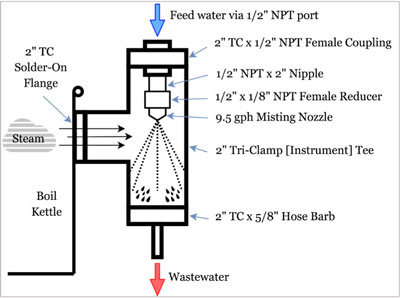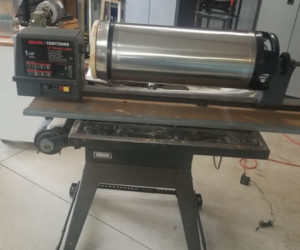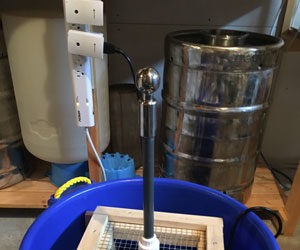Small-Scale Brewery Steam Condenser

Unequivocally, the evolution to electric power from traditional propane-based homebrewing has been the most significant advance for homebrewers. Electricity is quieter, more efficient, readily available, cleaner, and less expensive than propane. As a result, one of the major opportunities electric power offers homebrewers is to move their breweries indoors, eliminating the variabilities mother nature brings as a brewing partner: Temperature, wind, precipitation, and bugs!
One of the major headaches with indoor brewing, however, is the need to exhaust the steam generated during the boil. A typical ten-gallon (38-L) batch may expel as much as two gallons (7.6 L) of moisture into the surrounding atmosphere during the boil — enough to saturate even the most expansive basements! Electric brewing pioneers, such as TheElectricBrewery.com, implemented a ventilation system consisting of a hood, fan, and ducting to exhaust the hot vapor outside. A proper ventilation system must also return fresh air to eliminate placing a load on the home’s HVAC system. These can work well, but a great amount of hardware, planning, and funds are required — and for many brewers, the need to bore holes in their homes’ exterior walls is a deal breaker!
Borrowing a page from some industrial applications and pro brewing systems, I created a homebrew version of a steam condenser to mitigate the steam from the boil kettle. The concept is based on the principle that cooling steam below its phase-change temperature, while providing nuclei for condensation, will convert it back to water. Spraying cold water into a steam chamber serves this function, and both the condensed steam and spray water can be drained away together. The vapor’s volume contracts about 1,500 times from the phase change, which in turn creates a local vacuum, pulling in new air/steam and continuing the cycle without forced air.
The homebrew assembly is made by using a simple water-misting nozzle spraying inside a tee. The tee is mounted upright to the side of the kettle, so the lid can be used normally. The steam enters the tee and is cooled by the mist water there. The mist water and condensed steam flow down and out the bottom of the tee under gravity and is piped away with a drain tube.
The trade-off of this design is the ~7-10 gallons (26-38 L) of spray water which is dumped during its operation. Many may feel this is wasteful, but I chose to collect the water into five-gallon (19-L) buckets, which I will water my lawn with it. Since it contains the volatiles boiled off from the brew, including DMS, I suspect it cannot be repurposed for much else. Speaking of DMS, none of the beers made to date by myself or others using this steam condensor system have any detectable “cooked corn” or other off-flavors.
Parts
2-inch tri-clamp radius solder-on flange
(3) 2-inch tri-clamps
(3) 2-inch tri-clamp gaskets
2-inch tri-clamp x 1⁄2-inch NPT female coupling
2-inch tri-clamp x 5⁄8-inch hose barb
2-inch tri-clamp tee
9.5 gallons per hour misting nozzle (McMaster Carr)
1⁄2-inch x 1⁄8-inch NPT female reducer
1⁄2-inch NPT x 2-inch pipe nipple
3⁄4-inch OD silicone tubing



